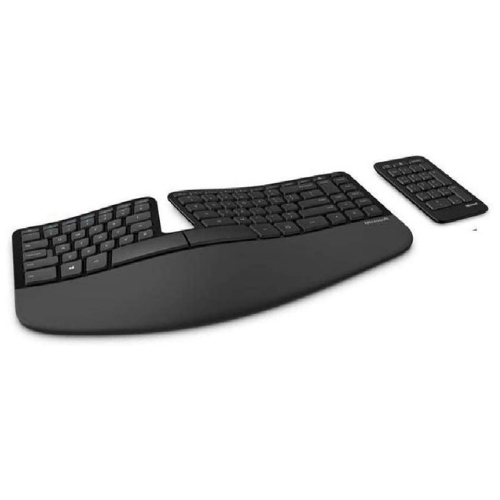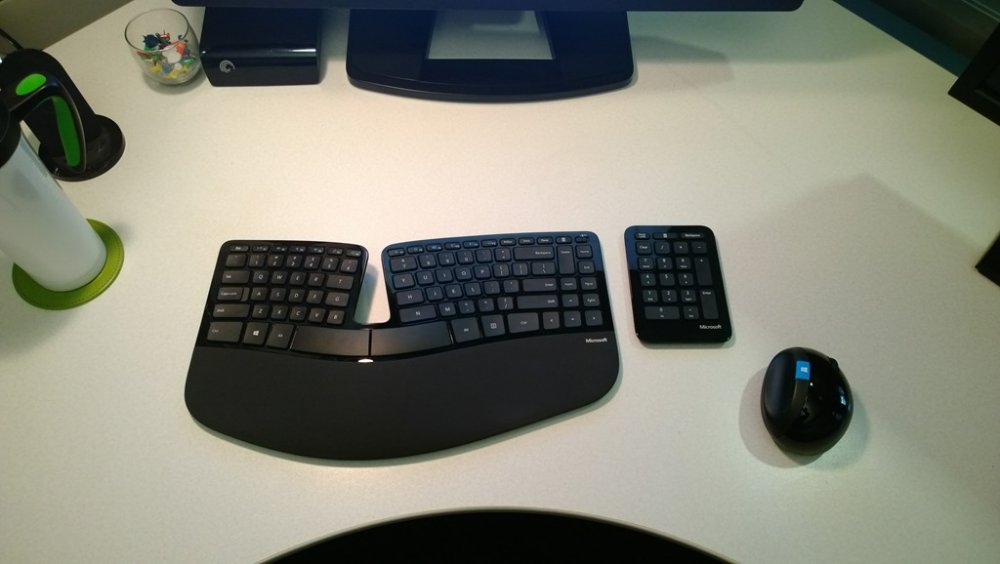Microsoft is a pioneer in the ergonomic keyboard space. The company released its first model, the Microsoft Natural Keyboard, way back in the early 1990s and has continued to drop new ones ever since. In 2013, Microsoft released its most ambitious ergonomic keyboard to date — the critically acclaimed Sculpt Ergonomic.
Even though the Microsoft Sculpt shares a similar layout to its predecessors, it’s unlike anything that came before. The keyboard features wireless connectivity, a tenkeyless frame, and a midnight black aesthetic that ushered in a new era of sleek minimalism. But the Sculpt isn’t perfect. Features that once made it great, like the 2.4GHz wireless connection and battery-operated power source, have diminished as newer, more powerful technology has emerged.
Join me on this Microsoft Sculpt Ergonomic Keyboard review, and let’s discuss whether this tried-and-true keyboard is still worth your money or well past its prime.
Microsoft Sculpt Ergonomic Keyboard Pros & Cons
- Integrated palm rest provides firm support while typing
- The 10° tenting angle and downward slope ensure optimal wrist positioning
- Reliable wireless connectivity actuates your keystrokes quickly and securely
- Requires disposable AAA batteries
- Scissor switch keys don’t offer the responsiveness of mechanical variants
- Lacks Bluetooth connectivity; the small USB receiver is irreplaceable

- Price: $80.95
- Layout: Fixed-split, tenkeyless
- Connectivity: Wireless
- Switches: Membrane Scissor
- Best for: Ergonomics, business
- Warranty: 3 Years
- Return Period: 30 Days
- Shipping: Free
- ABS-topped scissor switches feature minimal travel distance and reasonable tactility
- Tenkeyless layout features a 15.4″ wide design requires little hand movement or strain
- Keeps your keystrokes safe atop Microsoft’s 128-bit AES-encrypted 2.4 GHz wireless technology
Learn more about the Microsoft Sculpt Ergonomic Keyboard from these online retailers.
What Does the Microsoft Sculpt Ergonomic Keyboard Feel Like To Use?
The Microsoft Sculpt was the first ergonomic keyboard I ever used, way back in 2014. I still remember my initial discomfort with the bizarre design. Then, my growing acceptance. And finally, my respect and adoration.
While I have fond memories of its comfort and support, I’ve used many other ergonomic keyboards in the past several years. In other words, I’m no longer blind to the Sculpt’s now-apparent downsides. As great as the keyboard’s dome-like curve feels on your wrists and fingers, it shares that design with dozens of other, newer models.
For that reason, I’d prefer to talk about what sets the Microsoft Sculpt apart, starting with comfort and ergonomics.
Comfort & Ergonomics

Microsoft went with a tenkeyless design on the Sculpt Ergonomic. The company removed the traditional right-side number pad for a smaller, more compact frame. The advantage here is that you don’t have to extend your right hand to reach your mouse and return to touch typing position. Since the Sculpt comes with a standalone keypad, you also retain the same number-crunching benefits of a full-size model.
Typing is plenty comfortable whether you’re using the full keyboard or the separate keypad, as Microsoft’s scissor membrane switches operate at an ideal ~60 grams of force. The keys are also surprisingly tactile, providing a lovely spring that pushes back upon actuation. Although not nearly as responsive as a mechanical keyboard, I’ve been pleasantly surprised by the Scult’s sensory stimulation. The scissor switch’s momentum and quiet clicks combine to induce a little shot of dopamine every time you press a key.
Unlike SitWorkPlay’s favorite ergonomic keyboard — the Kinesis Freestyle Edge RGB — Microsoft’s Sculpt features a fixed frame that doesn’t split apart at the center seam. The benefit is that there’s no unsightly cord connecting the two pieces. But you do sacrifice precision ergonomics, as you can’t adjust the two sides to fit your typing style.
Fortunately, it’s still plenty supportive for most users. The 10° tenting angle and downward-sloping attachment ensure proper posture. Meanwhile, the supportive foam-like wrist rest is surprisingly cushy, offering a place to rest your hands between typing sessions.
Performance
The Sculpt connects to your computer via a 2.4 GHz USB wireless receiver. Just plug it in, and you’re in business. As a bonus, Microsoft pairs the keyboard and its receiver at the factory, offering 128-bit AES encryption that keeps your keystrokes safe on public networks. Unfortunately, the encrypted relationship plays out like Romeo and Juliet. When the keyboard or receiver dies or gets lost, the other dies with it — no replacements. I understand and enjoy the secure connection as much as the next user, but I wish the Sculpt came with an option for Bluetooth, as well. Then, the user could decide what’s best in any given situation.
This design quirk aside, it’s business as usual once you’ve connected to your Windows, macOS, or Linux machine. The keys respond well to every press, with every stroke actuating as expected. Even though I only type around 75 WPM, I’ve seen many users report that the Sculpt registers keystrokes at warp speed, up to 100+ WPM.
If you’d like to take your keyboarding up a notch, you can customize the keyboard with Microsoft’s Mouse and Keyboard Center 11. The software lets you bind macros to the top function and media keys for easy access to essential controls. Nothing fancy, but a nice touch, nonetheless.
Construction & Design
The Microsoft Sculpt incorporates the dome-shaped layout typical of ergonomic keyboards. This makes it supportive but incredibly bulky, measuring 1.5″ by 8.5″ by 15.5″. AKA, among the largest tenkeyless keyboards on the market. Even so, I love the way it looks. The keys feature a matte finish, while the frame is a metallic-looking plastic that sparkles majestically in the background.
Although I’d have liked to see PBT keycaps, which offer a durable, wear-resistant finish, the Sculpt’s ABS keys work well enough. They will start to fade within about a year of use, but it happens gradually, and you can see the lettering underneath. More importantly, this doesn’t affect the typing experience, which feels sturdy and secure, even with the downward-angled riser attached. The Sculpt is a masterclass in durable yet affordable ergonomics, only possible by a tech giant with the purchasing power of Microsoft.
I suppose my biggest frustration is the lack of backlighting. There doesn’t need to be anything fancy, but a solid-color white or red would do wonders for the overall vibe. It would also support visually impaired users or those who often work in the wee hours of night.
Our Verdict of the Microsoft Sculpt Ergonomic Keyboard

The Microsoft Sculpt Ergonomic Keyboard may be nearing its tenth birthday, but it still holds its own against the competition.
The tenkeyless design means you never have to move more than a foot from resting position, as your mouse is just a short flight over to your right. Returning to the center, the soft wrist rest offers a supremely comfortable runway for your wrists, holding them at the perfect angle for supportive touch typing. Meanwhile, the keys press down with moderate force, ensuring minimal travel distance and fatigue, even when typing for hours.
Concerning craftsmanship, the Sculpt’s minimal design elements and robust components provide the ideal blend of form and function. You’ll find many online reviewers touting the keyboard’s longevity, with some still using their Sculpt keyboards from the early 2010s.
Its wireless capability is one area where the Microsoft Sculpt begins to show its age. While the 2.4 GHz receiver with 128-bit encryption is a welcome feature that’s plenty fast and responsive, Microsoft should have included Bluetooth compatibility. If implemented on the Sculpt, it could have saved countless users from getting locked out of their product after losing the minuscule dongle.
At the end of the day, Microsoft managed to sculpt a masterpiece. It’s no Venus de Milo, but it has survived nearly a decade without losing relevance or supportiveness. If it were in my art class, I’d give it a solid A- for outstanding performance, building upon previous work with only a handful of oversights.
Other Models from Microsoft
- Microsoft Sculpt Comfort Desktop | Amazon ($50) – If you don’t mind a full-size keyboard and want a softer, more cushiony wrist rest, the Microsoft Sculpt Comfort Desktop may be for you.
- Surface Ergonomic Keyboard | Amazon ($129.99) – Whereas the Sculpt only supports 2.4 GHz connections, the Surface features Bluetooth 4.0 for better accessibility and ease of use.
- Microsoft Ergonomic Desktop | Amazon ($49.99) – Wireless keyboards are convenient, yes. But the Microsoft Ergonomic Desktop offers a wired keyboard and mouse for reliable connectivity that doesn’t skip a beat.
Comparable Keyboards from Other Brands
- Logitech K860 | Amazon ($129.99) – The Logitech K860 is the Microsoft Sculpt’s biggest competition. It features a slimmed-down full-size design that features Logitech Flow for enhanced business convenience.
- KINESIS Freestyle Edge RGB | Amazon ($219) – KINESIS is consistently ranked among the best ergonomic keyboards, and its split design with Cherry MX switches offers a buttery smooth and comfy typing experience.
- ErgoDox EZ ($354) – This keyboard may feature a bizarre design. But it’s the go-to option for users who need fine-tune adjustability capable of eliminating repetitive strain and carpal tunnel injuries.
Should You Buy The Microsoft Sculpt Ergonomic Keyboard?
As an early adopter and massive fan of the Microsoft Sculpt, I can genuinely recommend this keyboard to business professionals seeking a reliable and secure option that feels great for hours at a time. The supple wrist rest eliminates fatigue, and the keys press with minimal travel and excellent actuation.
That said, I don’t recommend the Sculpt to multitaskers who like to type on portable devices like tablets and phones. There is no Bluetooth support, and the receiver will not work for you. The Microsoft Sculpt is also a poor option for diehard environmentalists. The company could have included a rechargeable design but chose not to, an unfortunate oversight.
Throughout my time using keyboards, I’ve also come to prefer mechanical switches. While I’d still use the Microsoft Sculpt with enthusiasm, I’d encourage you to give the Kinesis Freestyle Edge RGB a shot if you have the dough to throw around.
Subscribe To SitWorkPlay
Email Sign-Up
"*" indicates required fields

